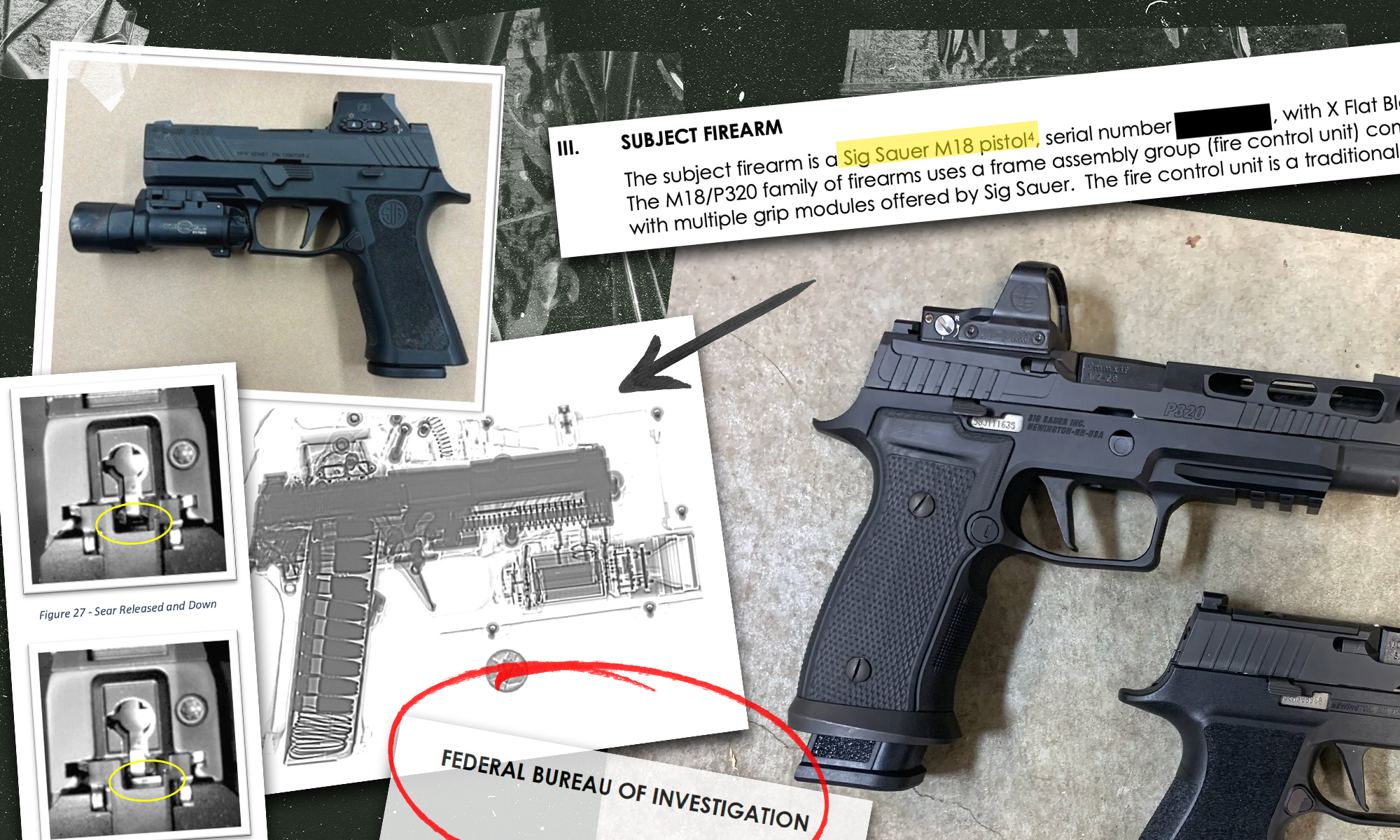A report by the FBI’s Ballistic Research Facility that was recently made public has placed the Sig Sauer M18/P320 series of striker-fired semi-auto pistols back into the spotlight. The report was based on the BRF’s tests of a Sig Sauer M18 that had been issued to a motor officer with the Michigan State Police. That pistol experienced an “uncommanded discharge” in July 2024, according to the document. The incident occurred while the gun was holstered, and in front of multiple witnesses. It joins a substantial list of similar reports, many of which have resulted in lawsuits.
The report was released Monday after a public-records request to the Michigan State Police, the agency confirmed to OL, and distributed Tuesday in a YouTube video. The results of the August 2024 report were inconclusive, but that hasn’t stopped a renewed flow of online speculation by people questioning the pistol’s design. At issue is whether the P320 and its variants are capable of an uncommanded discharge — meaning that the gun can potentially fire when there is no contact with or manipulation of the trigger.
A Years-Long Topic
This has been an ongoing dispute dating to 2017 when Sig Sauer initiated a “voluntary upgrade” to early-production P320s. Sig upgraded the P320’s trigger shoe with a disconnect notch at the rear of the slide, a captive striker safety lever, and a reduced-mass sear with a secondary engagement surface. These changes addressed an issue where the pistol could potentially fire when dropped from a height above current industry standards while striking the ground at a particular angle. Throughout the controversy, Sig has maintained that the pistol functions as designed and is only capable of firing when the trigger is pulled or forced rearward.
The Latest Concerns
With respect to the FBI report that was just made public, two observations stand out.
One is that the striker safety spring, which keeps pressure on a plunger that prevents the striker from moving forward, shifted position during one portion of the FBI’s test. If the spring were somehow dislodged, that could potentially negate that safety feature. The other was a test where the primary and secondary sear locks were intentionally overridden. During one iteration of this test, which was performed with the slide and frame being pressed together and pulled apart by hand while manually releasing the sear, the FBI was able to cause several empty primed cases to fire.
The problem with the first issue is that the window the FBI cut into the slide (in order to examine the striker safety spring under recoil) is part of what retains the spring. By removing that material, the spring was able to move.
The second issue is less clear. The FBI’s description of their test where its agents applied pressure and torque to the slide and frame is vague. And so far, the FBI hasn’t responded to OL’s requests for comment on the test.
A spokesman for Sig Sauer confirmed the test document’s authenticity for Outdoor Life, and was independently obtained by OL from the Michigan State Police.
The Never-Ending Story
What is certain is that this has been a persistent PR and legal headache for Sig Sauer. A cadre of online commentators have perpetuated the idea that the P320 series is inherently flawed, often citing anecdotes that support the idea that the pistol is subjectable to uncommanded discharges.
And Sig has faced multiple lawsuits over the P320, some of which have resulted in verdicts carrying substantial financial penalties.
Most of the lawsuits filed against Sig Sauer in respect to its P320 have been dismissed; however, the company lost 2024 jury decisions in Georgia and Pennsylvania. Earlier this year Sig’s home state of New Hampshire passed a bill that helps protect the company from future lawsuits.
The company maintains that the P320 is safe and these incidents are due to user error, such as improper handling or snagging on clothing or holsters or clothing.
Sig says they take all these accounts seriously, but have been unable to recreate an uncommanded discharge despite rigorous testing.
“At this point we have a pistol that’s been through rough handling and tested more than any other firearm in Sig Sauer’s history,” says Sig Sauer’s vice president of consumer affairs Phil Strader. “Our testing concludes that the only way for the pistol to fire is moved to the rear — it leaves us to question, how else is a pistol supposed to work?”
In the course of addressing the 2017 drop test by Omaha Outdoors test that led to the voluntary upgrade, Strader says Sig was only able to induce an issue when the pistol was dropped from a height above SAAMI and NATO specifications and noted that the P320 in its original form passed all industry rough handling protocols. The upgrades took an already safe pistol and made it safer, he says.
P320 Sales Remain Strong
While online debate about the P320 hasn’t run out of steam, it doesn’t seem to have gained widespread traction with handgun buyers. Sales of the P320 during the first half of 2025 have outperformed other firearms on Guns.com, according to the site’s director of digital marketing Will Altherr.
“Since January 2024, Guns.com has maintained a stable sales volume for the SIG Sauer P320 series,” Altherr says. “In the first half of 2025, sales declined by a modest 1.7 percent while the broader firearm market contracted by approximately 3.9 percent. This comparatively steady performance over the past 18 months suggests enduring consumer interest in the P320 platform.”
Other gun sellers are still reporting healthy P320 sales, which is noteworthy considering gun sales are down between 10 and 15 percent right now “depending who you talk to,” says Richard Sprague, president of the eponymous Sprague’s Sports in Yuma, Arizona.
At Sprague’s, Sig P320 models sales are actually up 59 percent in 2025 compared to the same period last year. Sprague also checked with six of his key salesmen, who reported that “only haters bring up” the P320 controversy at the gun counter.
“They said it had no real impact and said it barely comes up,” Sprague says, noting that many customers are military or Border Patrol personnel . “Those who do [mention it] are mainly people who want to hate — like an HK guy or a Glock guy.”
While several large agencies have moved away from Sig amid safety concerns, the vast majority of agencies and units that reassessed the pistol after adopting it have continued to use it.
Read Next: 22 ARC vs. 22 Creedmoor: A 3,000-Round Range Test
“Any agency that’s taken the time to ask questions and do their due diligence has stuck with it,” says Sig’s Strader.
That includes the Michigan State Police, which is at the center of this latest chapter in the Sig P320/M18 saga.
Natalie Krebs contributed reporting.
Read the full article here









![Dems Release New Epstein Photos to Smear Trump, It Immediately Blows Up in Their Face [WATCH] Dems Release New Epstein Photos to Smear Trump, It Immediately Blows Up in Their Face [WATCH]](https://www.lifezette.com/wp-content/uploads/2025/11/2025.11.13-01.15-lifezette-6915da05cf827.jpg)


